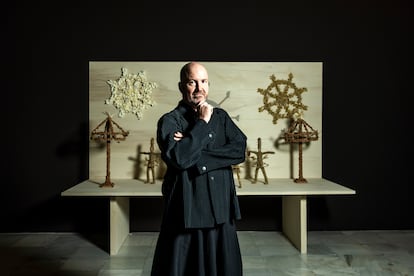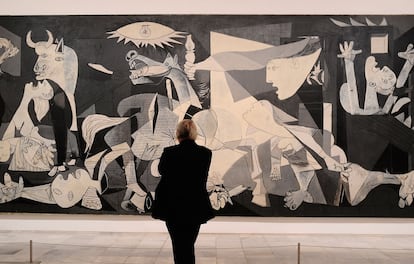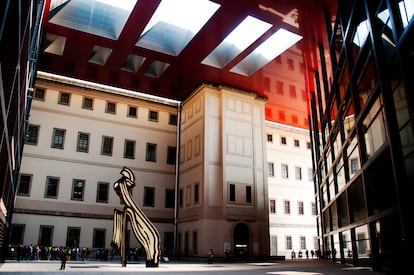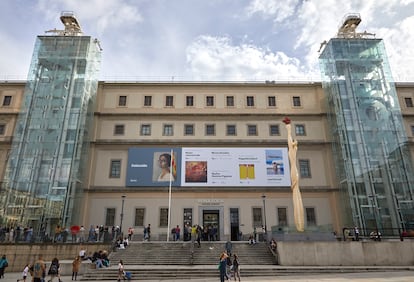Manuel Segade (A Coruña, 48 years old) arrives at half of his term at the head of the Reina Sofía Museum, but this Ecuador looks more at the beginning of his management because at this time he has had to devote himself to the exhibitions than his predecessor in office, Manuel Borja-Villel, left scheduled. “At the public visibility level it is now when the transformation in the program will be noticed,” he acknowledges. At this time, he says, he has focused on changing the work culture of a transatlantic of contemporary art with more than 700 employees, to devise the reorganization of the permanent collection through the project of a new museum model that pretends to be friendlier with the visitor. That is, they stop repeating that he directs a labyrinth in which he is complicated until he finds the Guernica.
Ask. How have you managed the inheritance received?
Answer. I make a hyperpositional balance. The same one I did when I arrived: I have not found corpses under the carpets.
P. He has just presented the new exhibition season, what does he say about you and your project for the museum?
R. The most important change will occur when the new reorganization of the permanent collection is presented in February 2026, with a first stage from the seventies to the present. That is the time when you are going to see where the museum wants to go. The exhibition program is fundamental, we premiered with Maruja Mallo. It is something we will continue doing without pause: rescue the artists and practices that have been invisible.
P. Why is the permanent collection so relevant, then?
R. The collection will allow us to stop being a maze, one of the main complaints of visitors. For me it is important that we recover a very basic idea that has to do with how museums were defined already in the 18th century: they must have the monumental dimension of the State and the comfort of the domestic. We have forgotten the domestic over the years because we have been very focused on programming.
P. How is a museum of this size to be more comfortable?
R. The entrance will be an area of being where educational activities can be produced, making meetings or simply resting. We are raising a new interior design of the furniture. Childbirth of a feminist thought: from the least to the highest. The content is fundamental, I want it to understand that the collection not only deals with the Spanish, but that the reorganization is made from here. At the same time I care more than that form is understood.
P. Can you give me an example?
R. The ease of moving from one room to another, that the texts are open and simple so that everyone can understand them. That ability to speak and collects you. In 2028, we will have transformed the entire building.
P. What do visitors complain? They listen to them?
R. They usually complain that the museum looks like a labyrinth, that they are lost, that they do not find pleasant rest areas, that a breastfeeding room is missing … we have a multidisciplinary team in this and we are making changes such as with the audioguías, the maps of the museum, propose another reception for the people who do hours of queue to enter at 18.30 when the museum is already free and raise two entries for temporary exhibitions and permanent. The objective is how to include more people, how to generate accessibility and how to ensure that anyone can approach contemporary art.
P. Have you fixed the problems they had with the lack of room guards?
R. We have hired 147 new guards and more than 30 officials to cover the new works that did not exist. We are more than 700 employees and this will allow it to work more horizontally and interrelationly that, sometimes, is what is needed in these administrative structures.
P. The Government still does not approve general budgets and national museums such as Queen Sofia are largely supported by these items. How does it affect you when programming an exhibition season?
R. We have the same budget as in 2023, that is, every year less money. But it is true that we have the total support of the Ministry of Culture and that helps to have a financial impulse at the time we need to do something.

P. For a few years now there
R. Cultural structures such as a national museum are political structures, in the sense that they are directed to the polis and that they are mirrors of society. César Aira, the Argentine writer, said that museums are the machines to give definitions of a society. I share it. It does not say a definition, but to give clear definitions. I would like anyone to enter this museum to find things to identify and things to worry about in order to have their attention. Culture is for that.
P. How do you do it?
R. With very diverse programs. This year we have Félix González-Torres: a hyper conceptual and emotional art, of the generation of the AIDS crisis. Exhibitions of the thirties, of the Republic, of the textile of the sixties, of Aurèlia Muñoz, and the painting of Juan Uslé. Popular art and high art. It is essential that we maintain that broad spectrum.
P. Can art not be a political?
R. A museum has to be a space in which people can expand their knowledge, answer their own opinions and simply recognize that complexity of the world in which we live. Many times they have asked me if our museum had to take part in a conflict or should simply talk about him. I insist, Queen Sofia was founded as a museum in 1992, thanks to the transfer of the Guernica From the manson of good retirement. And I ask, what is the Guernica? You just have to see what is happening now in the demonstrations against Israeli bombings in Gaza, people go out with the Picasso painting. This work was used against the Vietnam War, against that of Ukraine. Art is always before.

P. Is this debate exhausted: that they indicate as political or aligned institutions with the government on duty?
R. Now there is a fashion that museums have become feminist, or we are interested in ethnic minorities or social class. It turns out that this is where I think there is a fundamental duty that corresponds to us and that it will have a lot of reflection in the collection that we are going to present. The culture itself that the Cobija museum talks about these issues. It is as if we pretend that the Prado does not treat the monarchy or the aristocracy. There is no other than to be talking continuously from this from different sides. The museum, in a way, takes sides, but also opens discussions.
P. Do you ever feel directly attacked?
R. I don’t feel an extreme attack because museums are full of people interested in art. Many of the attacks, for example, through social networks, are of people who will never be the public of our museums. Maybe, at one point, everything becomes conservative and we will have to think if we want to support that vision of culture.
P. There are already cultural wars, again.
R. It makes it clear that culture is fundamental, that certain spectra of Spanish or international society bother them certain cultural products. It indicates that the power of representation, that is, the power of the imaginary exercise about how real the artists have is a strong power. My only militancy in that regard is that we need critical and public free public.
P. Every year the museums beat visits records and is due, in part, to the rise of tourism. At this time when the model is questioned and how it affects cities, how do you live it?
R. The number of tourists has risen 10% in the central headquarters of the museum. It is a tourism that pays entrance, of a specific sociocultural profile that is evidently very advantageous to us. We are not going to deny it. At the same time, we have not reached any limit, as can happen in the Louvre. It does not seem to me a problem right now, the day we really face a massive and extreme tourism we will have to study it.

P. The proximity to Queen Sofia is one of the claims in the advertisements of the tourist rentals.
R. We work hard with the groups and the different activist associations of the neighborhood. Madrid’s gentrification is a clear fact that the museum participates. In that there is no doubt. We are not naive. If we want this to be a care museum, you have to extend those care at other levels. And that is what we are trying deeply.
P. He still has half of his mandate and can renew, but would he like that his legacy?
R. The directors are remembered for an exhibition or something of the program, but I am much more interested in execution, the way I can change the museum.

